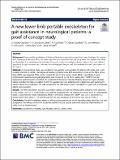Por favor, use este identificador para citar o enlazar a este item:
http://hdl.handle.net/10261/219084COMPARTIR / EXPORTAR:
 SHARE SHARE
 CORE
BASE CORE
BASE
|
|
| Visualizar otros formatos: MARC | Dublin Core | RDF | ORE | MODS | METS | DIDL | DATACITE | |

| Campo DC | Valor | Lengua/Idioma |
|---|---|---|
| dc.contributor.author | Puyuelo-Quintana, G. | es_ES |
| dc.contributor.author | Cano-de-la-Cuerda, R. | es_ES |
| dc.contributor.author | Plaza-Flores, A. | es_ES |
| dc.contributor.author | Garces-Castellote, E. | es_ES |
| dc.contributor.author | Sanz-Merodio, D. | es_ES |
| dc.contributor.author | Goñi-Arana, A. | es_ES |
| dc.contributor.author | Marín-Ojea, J. | es_ES |
| dc.contributor.author | García-Armada, E. | es_ES |
| dc.date.accessioned | 2020-09-03T17:07:56Z | - |
| dc.date.available | 2020-09-03T17:07:56Z | - |
| dc.date.issued | 2020-05-06 | - |
| dc.identifier.citation | Journal of NeuroEngineering and Rehabilitation 17 (1): 60 (2020) | es_ES |
| dc.identifier.uri | http://hdl.handle.net/10261/219084 | - |
| dc.description.abstract | Background: Few portable exoskeletons following the assist-as-needed concept have been developed for patients with neurological disorders. Thus, the main objectives of this proof-of-concept study were 1) to explore the safety and feasibility of an exoskeleton for gait rehabilitation in stroke and multiple sclerosis patients, 2) to test different algorithms for gait assistance and measure the resulting gait changes and 3) to evaluate the user's perception of the device. Methods: A cross-sectional study was conducted. Five patients were recruited (4 patients with stroke and 1 with multiple sclerosis). A robotic, one-degree-of-freedom, portable lower limb exoskeleton known as the Marsi Active Knee (MAK) was designed. Three control modes (the Zero Force Control mode, Mode 1 and Mode 3) were implemented. Spatiotemporal gait parameters were measured by the 10-m walking test (10MWT), the Gait Assessment and Intervention Tool (G.A.I.T.) and Tinetti Performance Oriented Mobility Assessment (gait subscale) before and after the trials. A modified QUEST 2.0 questionnaire was administered to determine each participant's opinion about the exoskeleton. The data acquired by the MAK sensors were normalized to a gait cycle, and adverse effects were recorded. Results: The MAK exoskeleton was used successfully without any adverse effects. Better outcomes were obtained in the 10MWT and G.A.I.T. when Mode 3 was applied compared with not wearing the device at all. In 2 participants, Mode 3 worsened the results. Additionally, Mode 3 seemed to improve the 10MWT and G.A.I.T. outcomes to a greater extent than Mode 1. The overall score for the user perception of the device was 2.8 ± 0.4 95% CI. Conclusions: The MAK exoskeleton seems to afford positive preliminary results regarding safety, feasibility, and user acceptance. The efficacy of the MAK should be studied in future studies, and more advanced improvements in safety must be implemented. | es_ES |
| dc.description.sponsorship | G. Puyuelo-Quintana has received financial support by the “Doctorado Industrial” grant of Ministerio de Ciencia, Innovación y Universidades de España (reference DI-16- 08731). A. Plaza-Flores and E. Garces-Castellote have received financial support by the “Doctorado Industrial” grant of Comunidad de Madrid (reference IND2017/TIC-7698 and IND2018/TIC-9618, respectively). | es_ES |
| dc.language.iso | eng | es_ES |
| dc.publisher | BioMed Central | es_ES |
| dc.relation | IND2018/TIC-9618 | es_ES |
| dc.relation | IND2017/TIC-7698 | es_ES |
| dc.relation.isversionof | Publisher's version | es_ES |
| dc.rights | openAccess | es_ES |
| dc.subject | Exoskeletons | es_ES |
| dc.subject | Feasibility | es_ES |
| dc.subject | Gait | es_ES |
| dc.subject | Multiple sclerosis | es_ES |
| dc.subject | Safety | es_ES |
| dc.subject | Stroke | es_ES |
| dc.title | A new lower limb portable exoskeleton for gait assistance in neurological patients: a proof of concept study | es_ES |
| dc.type | artículo | es_ES |
| dc.identifier.doi | 10.1186/s12984-020-00690-6 | - |
| dc.description.peerreviewed | Peer reviewed | es_ES |
| dc.relation.publisherversion | https://doi.org/10.1186/s12984-020-00690-6 | es_ES |
| dc.identifier.e-issn | 1743-0003 | - |
| dc.contributor.funder | Ministerio de Ciencia, Innovación y Universidades (España) | es_ES |
| dc.contributor.funder | Comunidad de Madrid | es_ES |
| dc.relation.csic | Sí | es_ES |
| oprm.item.hasRevision | no ko 0 false | * |
| dc.identifier.funder | http://dx.doi.org/10.13039/100012818 | es_ES |
| dc.contributor.orcid | Puyuelo-Quintana, G. [0000-0002-4989-8830] | es_ES |
| dc.contributor.orcid | Cano-de-la-Cuerda, R. [0000-0002-1118-4234] | es_ES |
| dc.contributor.orcid | Sanz-Merodio, D. [0000-0002-7978-683X] | es_ES |
| dc.contributor.orcid | Goñi-Arana, A. [0000-0002-4233-7950] | es_ES |
| dc.identifier.pmid | 32375815 | - |
| dc.type.coar | http://purl.org/coar/resource_type/c_6501 | es_ES |
| item.cerifentitytype | Publications | - |
| item.openairecristype | http://purl.org/coar/resource_type/c_18cf | - |
| item.grantfulltext | open | - |
| item.openairetype | artículo | - |
| item.fulltext | With Fulltext | - |
| item.languageiso639-1 | en | - |
| Aparece en las colecciones: | (CAR) Artículos | |
Ficheros en este ítem:
| Fichero | Descripción | Tamaño | Formato | |
|---|---|---|---|---|
| A_new_lower_limb_portable_exoskeleton.pdf | Artículo principal | 2,42 MB | Adobe PDF |  Visualizar/Abrir |
CORE Recommender
PubMed Central
Citations
9
checked on 25-abr-2024
SCOPUSTM
Citations
31
checked on 23-abr-2024
WEB OF SCIENCETM
Citations
29
checked on 26-feb-2024
Page view(s)
145
checked on 25-abr-2024
Download(s)
170
checked on 25-abr-2024
Google ScholarTM
Check
Altmetric
Altmetric
Artículos relacionados:
NOTA: Los ítems de Digital.CSIC están protegidos por copyright, con todos los derechos reservados, a menos que se indique lo contrario.
